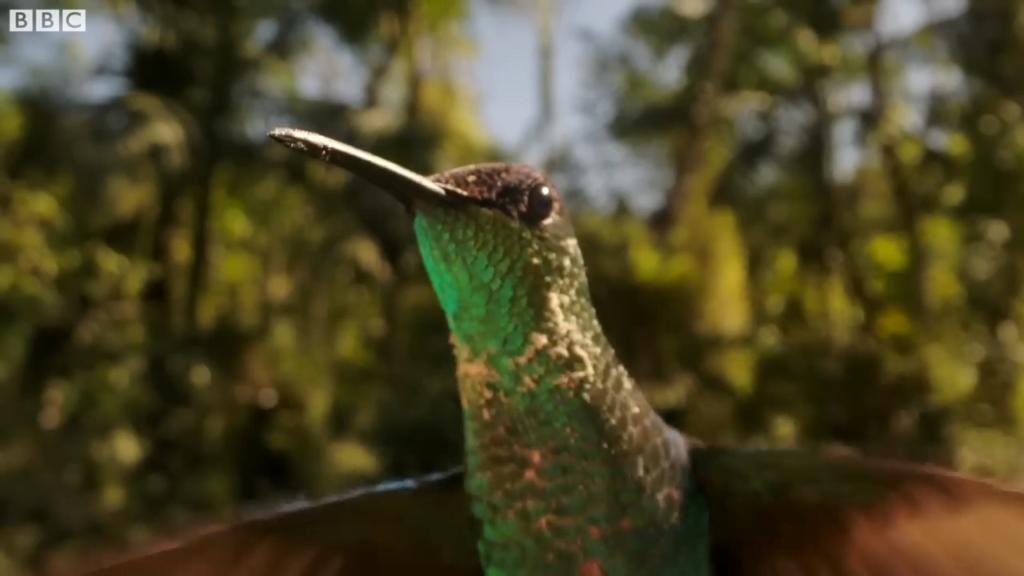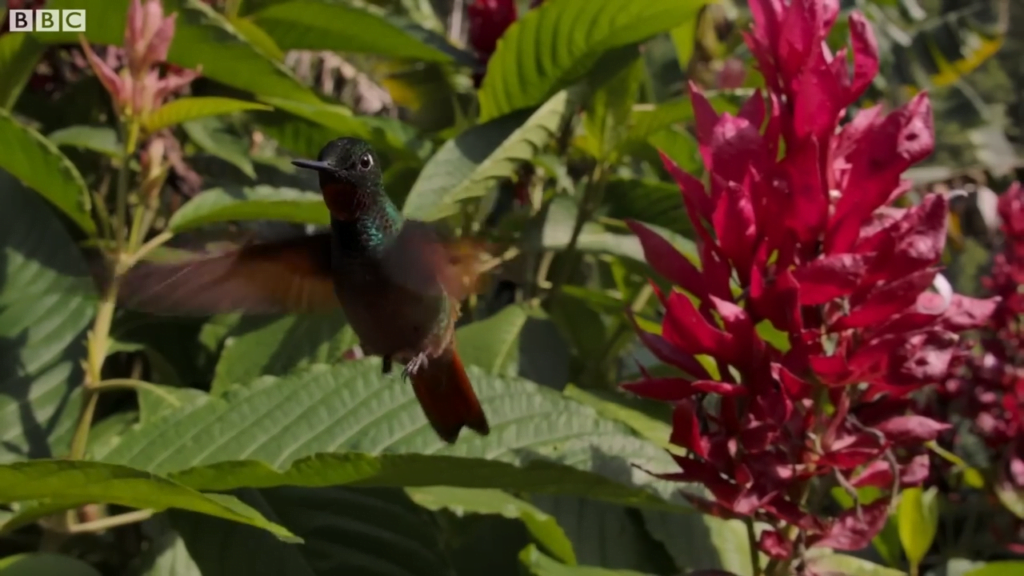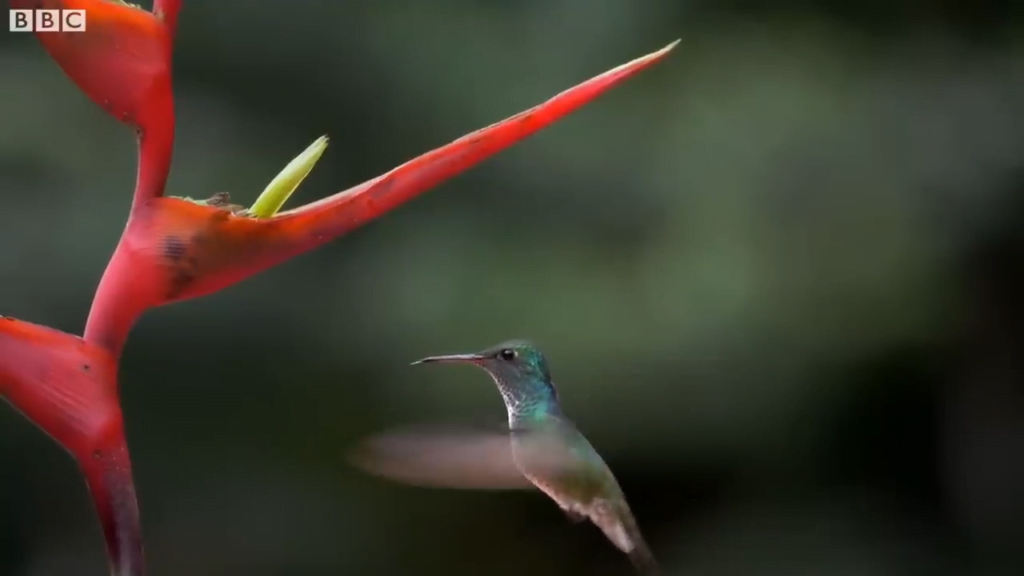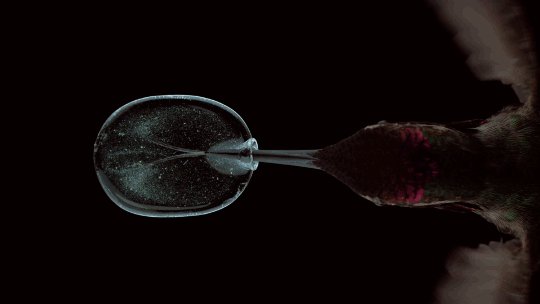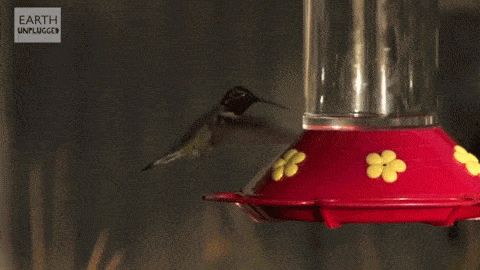Quick, agile, and fierce, the hummingbird is an amazing creature. Small for a bird but much larger than an insect, it’s able to hover in place and eat nectar directly from flowers. Many species use a forked tongue with curled edges that help it capture the sweet, viscous fluid. Even their distinctive sounds are fluid-influenced, coming from their wingstrokes and the fluttering of tail and wing feathers. (Image and video credit: BBC Earth)
Tag: hummingbird

How the Hummingbird Got Its Hum
Summer hikes in the Rocky Mountains are frequently pierced by a hum that can deepen to a bomber-like buzz as hummingbirds flit by. They’re so small and fast that they’re hard to see, but they’re never hard to hear. A new study pins down just where that telltale hum comes from.
To determine the specific origin of the hummingbird’s sound, researchers observed hovering hummingbirds with an array of over 2,000 microphones and multiple high-speed cameras. With this set-up, they could create a 3D acoustic map of the bird’s sounds, correlated with its motions. They found that the bird’s sounds come primarily from aerodynamic forces generated during their distinctive wingstroke – not from vortices or the fluttering of their feathers.
They also found that the hummingbird’s fast wingstroke — about 40 times per second — fed into sounds at 40 and 80 Hz, as well as higher frequency overtones. Since these sounds are well within human hearing range, they make up most of what we hear from the birds. (Image credit: P. Bonnar; research credit: B. Hightower; via The Guardian; submitted by Kam-Yung Soh)

Hummingbird Flight in Slow Motion
Hummingbirds are impressive, acrobatic flyers. Their figure-8 wing stroke pattern produces about 70% of their lift on the downstroke, and the remainder during the backward upstroke. But their tails and body motions also play an important role in stabilizing them, especially in gusty winds. They also have some impressive feeding dynamics. Altogether, they’re one of the most precise flyers in the animal kingdom! (Video and image credit: BBC Earth)

Audubon Photography Awards
Several of this year’s Audubon-Photography-Award-winning photos feature birds interacting with fluids. The Grand Prize Winner, by Joanna Lentini, features a diving double-crested cormorant. Like many other species, these cormorants launch themselves into shallow waters from above and endure some incredible forces to do so. They’re no slackers underwater, either; when I encountered a flightless cormorant while snorkeling in the Galapagos, it outswam me in an instant.
The other prize winners above are a little more splashy. The American dipper’s splash curtain comes from sticking its head underwater in search of prey. The Anna’s hummingbird seen in the last image is playing in the spray of a fountain and showing off its aerial agility while doing so! (Image credits: cormorant – J. Lentini, dipper – M. Fuller-Morris, hummingbird – B. Ghosh; via DPReview; submitted by Kam-Yung Soh)

Hovering
Nectar-drinking species of hummingbirds and bats are both excellent at hovering – one of the toughest aerodynamic feats – but they each have their own ways of doing it. Hummingbirds (bottom) use a nearly horizontal stroke pattern that’s quite symmetric on both the up- and downstroke. To keep generating lift in the upstroke, they twist their wings strongly midway through the stroke. So although hummingbirds get most of their lift from the downstroke, they get quite a bit from the upstroke as well.
Bats, on the other hand, use an asymmetric wingbeat pattern when hovering. Bats flap in a diagonal stroke pattern, using a high angle of attack in the downstroke and an even higher one during the upstroke. They also retract their wings partially during the upstroke. This flapping pattern gives them weak lift during the upstroke, which they compensate for with a stronger downstroke. Compared to non-hovering bat species, nectar-drinking bats do get more lift during the upstroke, but they’re nowhere near as good as the hummingbirds. The bats compensate by having much larger wings compared to their body size. Bigger wings mean more lift.
In the end, the two types of hovering cost roughly the same amount of power per gram of body weight. That’s great news for engineers designing the next generation of flapping robots because it suggests two very different, but equally power-efficient methods for hovering. (Image credit: Lentink Lab/Science News, source; research credit: R. Ingersoll et al.; via Science News; submitted by Kam Yung-Soh)

How Hummingbirds Drink
Hummingbirds are incredible acrobatic fliers, capable of hovering for more than 30 seconds at a time, even in windy conditions. Their feeding habits are equally impressive. Many species of hummingbirds have a forked tongue, each half of which curls over like a partial straw. As the bird extends its tongue, its beak compresses the space inside the tongue’s curls. Once in the nectar, both halves of the tongue re-expand, pulling liquid in along the full length of the tongue. For the birds, this is a much faster technique than simply sucking the nectar up like a straw. Hummingbirds can lick nectar more than ten times a second this way. For more gorgeous imagery of hummingbirds, be sure to check out National Geographic’s full feature. (Image credit: A. Varma, source; via Aarthi S.)

Hummingbird Drinking

Hummingbirds are master acrobats, able to hover and drink simultaneously before flitting off to the next flower. At first glance, you might expect that their tongues are simply tiny straws that use surface tension and capillary action to draw up nectar. But it turns out that process is just too slow for the fast-paced birds.
Instead, hummingbirds use a forked tongue with a long groove on either half. When the hummingbird extends its tongue, its beak compresses the grooves and squeezes them together. Once the tongue reaches nectar, the grooves expand, which draws nectar up along the full length of the tongue grooves. This allows the bird to fill its tongue much faster than it could otherwise, enabling the hummingbird to lick up nectar more than 10 times a second.
There’s a neat excerpt from a documentary including this research over here (Tumblr won’t allow the embedded version); the full documentary premieres today on PBS. (Image credits: A. Rico-Guevara et al., sources 1,2; submitted by mypronounsareherrchancellor)

Fluttering Feathers
Birds do not always vocalize in order to make their songs. The male African broadbill, shown in the top video above, makes a very distinctive brreeeet in its flight displays, but as newly published research shows, the sound comes from its wings, not its voice. During the display, the broadbill spreads its primary feathers and sound is produced on the downstroke, when wingtip speeds reach about 16 m/s. By filming a broadbill wing with a high-speed camera in a wind tunnel at comparable air speeds, researchers could localize the sound production to the 6th and 7th primary feathers.
In the second video above, you can see these feathers twisting and fluttering in the breeze. This is an example of aeroelastic flutter, a phenomenon in which aerodynamic and structural forces couple to induce oscillations. The same phenomenon famously caused the collapse of the Tacoma Narrows Bridge in 1940. In the birds, however, the flutter is non-destructive and the vibration produces audible sound which the other feathers modulate into the calls we hear. Broadbills aren’t the only birds to use this trick; some species of hummingbirds use flutter in their tail feathers during mating displays. (Video, image, and research credits: C. Clark et al.; additional videos here)

Hovering Hummingbirds

Hummingbirds are incredible flyers, especially when it comes to hovering. To hover stationary and stable enough to feed, the hummingbird’s flapping pattern not only has to generate enough lift, or vertical force, to counteract their weight, but the bird must balance any forward or backward forces generated during flapping.
As you can see in the animations above, when hovering the hummingbird’s wings move forward and back rather than up and down. When slowed down even further, the figure-8 motion of the wings becomes apparent. This careful motion is key to the hover; it allows the bird to generate about 70% of its lift on the downstroke when the wings move forward and creates the remainder of the lift needed on the upstroke. For much more high-speed footage of hummingbirds, check out the full BBC Earth Unplugged video, but be warned: you may experience a cuteness overdose! (Image credit: BBC Earth Unplugged, source)

